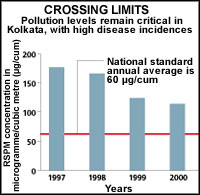Penetrating evidence
 For those immune to the known dangers of vehicular pollution, a new study comes up with a shocker. The study paints an even more scary picture of the losing battle fought by the lung's defence mechanism against air pollution. Genetic disruption and neurobehavioural problems are also part of the package. The study shows that whether on road or at home, there is no respite from the clutches of toxic fumes, especially of vehicular emissions. "Indicting any particular pollutant means targe-ting respirable suspended particulate matter,' the study states.
For those immune to the known dangers of vehicular pollution, a new study comes up with a shocker. The study paints an even more scary picture of the losing battle fought by the lung's defence mechanism against air pollution. Genetic disruption and neurobehavioural problems are also part of the package. The study shows that whether on road or at home, there is no respite from the clutches of toxic fumes, especially of vehicular emissions. "Indicting any particular pollutant means targe-ting respirable suspended particulate matter,' the study states.
Researchers from Kolkata-based Chittaranjan National Cancer Institute (cnci) and Calcutta University conducted the study over a period of six years. Among others, the research team included Twisha Lahiri, Senjuti Roy, Chandreyi Basu, Manas Ranjan Ray and Pulak Lahiri. The researchers compared the health problems of 1,310 urban residents with that of 200 rural residents. Almost three-fourths of the people in the city were found to have some form of respiratory problem, and about half of them had damaged lungs. In comparison, less than half the rural residents had respiratory problems. Oral cavity cells are the first to suffer from the menace of air pollution. The researchers discovered that these cells were extensively damaged in the study subjects. Their chromosomes had micronuclei, indicating genetic disruption. The rate of this process in the urban population was found to be twice that of the rural population.
To find out the worst affected lot among the urban residents, the researchers divided them into three subgroups: those who are highly exposed to vehicular emissions, like traffic policemen, drivers, garage workers and hawkers; those who are highly exposed to combustion fumes, like firefighters, asphalt workers, factory workers and canteen workers; and those who are relatively less exposed to both vehicular and combustion fumes, like office workers, housewives, maids and students.
At least 79 per cent of the hawkers, who spend a very large amount of time outdoors and were therefore regularly exposed to vehicular exhaust, were found to have the most damaged lungs amongst the three subgroups. Next were the garage workers, who are also exposed to high levels of vehicular exhaust. Sixty per cent of them had damaged lungs. However, most of the students were found to be healthy, with only 18 per cent of them having impaired lungs. Though smoking was found to aggravate problems in general, the number of hawkers with damaged lungs who smoked and who did not was almost equal. (See Graph)
Upon delving deeper into what was happening inside the lungs and other body parts, the researchers found that outward symptoms like respiratory problems were just the tip of the iceberg. When they studied the alveolar macrophages (am)
